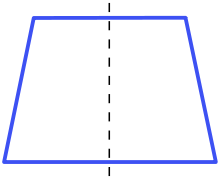Isosceles trapezoid
| Isosceles trapezoid | |
|---|---|

Isosceles trapezoid with axis of symmetry
|
|
| Type | quadrilateral, trapezoid |
| Edges and vertices | 4 |
| Symmetry group | Dih2, [ ], (*), order 2 |
| Dual polygon | Kite |
| Properties | convex, cyclic |
In Euclidean geometry, an isosceles trapezoid (isosceles trapezium in British English) is a convex quadrilateral with a line of symmetry bisecting one pair of opposite sides. It is a special case of a trapezoid. In any isosceles trapezoid two opposite sides (the bases) are parallel, and the two other sides (the legs) are of equal length (properties shared with the parallelogram). The diagonals are also of equal length. The base angles of an isosceles trapezoid are equal in measure (there are in fact two pairs of equal base angles, where one base angle is the supplementary angle of a base angle at the other base).
Rectangles and squares are usually considered to be special cases of isosceles trapezoids though some sources would exclude them.
Another special case is a 3-equal side trapezoid, sometimes known as a trilateral trapezoid or a trisosceles trapezoid. They can also be seen dissected from regular polygons of 5 sides or more as a truncation of 4 sequential vertices.
Any non-self-crossing quadrilateral with exactly one axis of symmetry must be either an isosceles trapezoid or a kite. However, if crossings are allowed, the set of symmetric quadrilaterals must be expanded to include also the crossed isosceles trapezoids, crossed quadrilaterals in which the crossed sides are of equal length and the other sides are parallel, and the antiparallelograms, crossed quadrilaterals in which opposite sides have equal length.
Every antiparallelogram has an isosceles trapezoid as its convex hull, and may be formed from the diagonals and non-parallel sides of an isosceles trapezoid.
If rectangles are included in the class of trapezoids then one may concisely define an isosceles trapezoid as "a cyclic quadrilateral with equal diagonals" or as "a cyclic quadrilateral with a pair of parallel sides" or as "a convex quadrilateral with a line of symmetry through the mid-points of opposite sides".
...
Wikipedia
